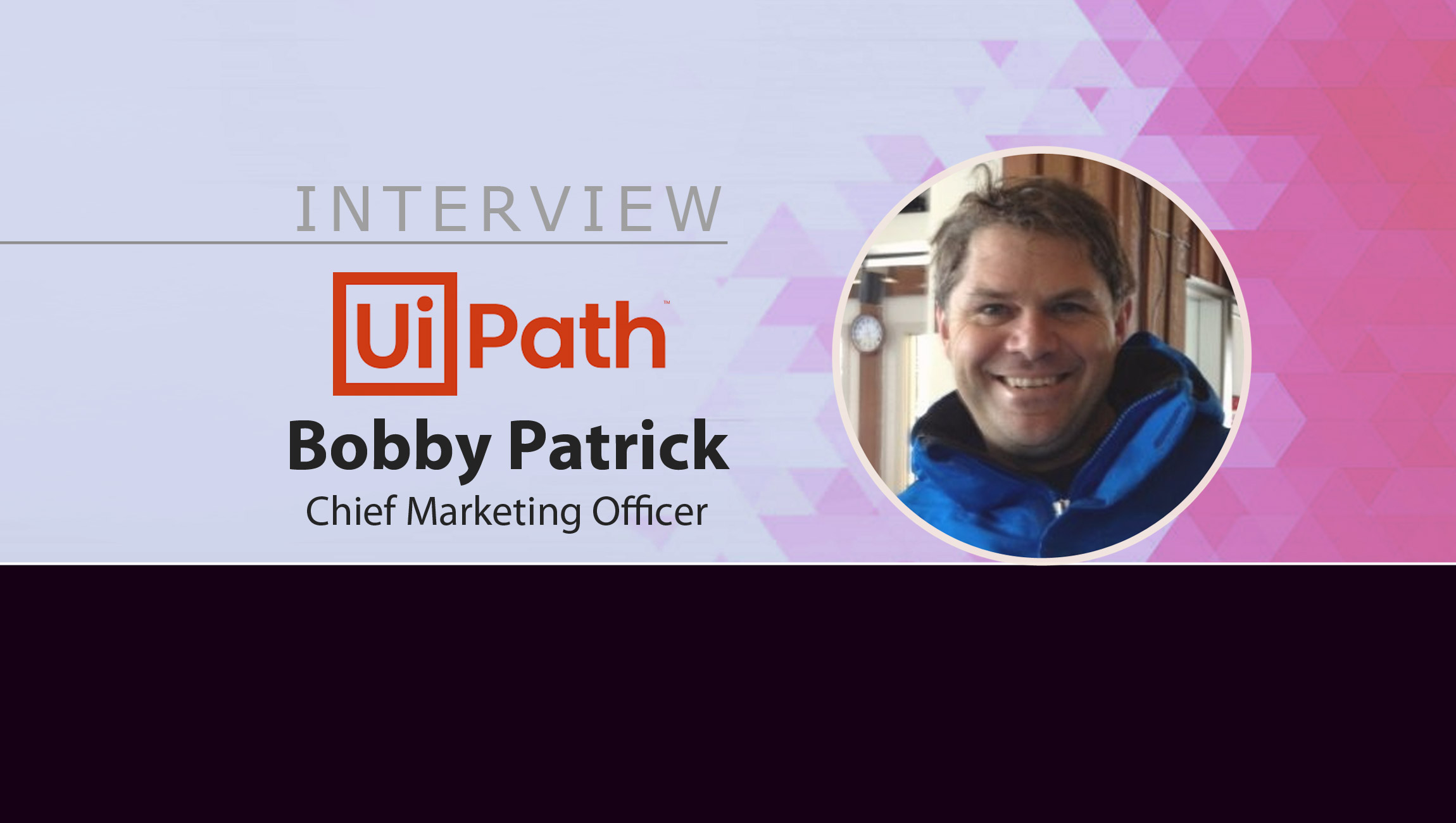Bobby Patrick, Chief Marketing Officer at UiPath talks about the growing use of software robots and how they can enable better customer engagement while improving the overall customer experience: _______ My role as CMO at UiPath is not only to drive the marketing of the business, but to define, elevate and evolve an entire industry. At UiPath, I focus on making automation a top strategic priority for every company in every industry. To illustrate how important marketing is at UiPath, all you need to do is look at the actions of our leadership. When the business raised its Series A in 2017, the first executive role that Daniel Dines, UiPath’s founder and CEO, hired for was marketing. It showed how critical the company viewed marketing to raise awareness of the firm and the category. We went from fifth place in the industry that year to #1 in 2018. Today, we have over 30% market share and are adding more new revenue that our top nine competitors combined. It’s been a very exciting ride but the potential for humans and robots to collaborate together is only just getting started. Marketing Technology News: MarTech Interview with Noel Hamill, CMO at Forsta I began my career as a computer specialist in the FBI at age 16 and quickly evolved to coding business applications. I’ve always seen technical depth and product strategy as vitally important alongside strategic marketing, demand generation and communications. This helps make sure that marketing is never fluff. My time at UiPath is no different. My experience here shows that marketers need to actually use and understand their products; how they actually work and the true value they deliver. To this end, we work directly with customers so they can help tell the story for us – both the positives and the challenges. That drives the most important result: word-of-mouth marketing. Certainly, we were concerned in early 2020 about the impacts of the coronavirus on our business. But we also knew that our proposition could actually help with the crisis. It could be used by hospitals, life sciences companies, government agencies, and more to manage the huge pressures on them. Within 30 days, we had 50 examples of automation being used to tackle the challenges introduced by the pandemic. This included pharma and healthcare firms like leading biotechnology company, Regeneron, and hospitals such as Mater in Dublin, Ireland. From a tactical point of view, everything had to rapidly shift to 100% digital. This required accelerating the integration of all of our digital touch points to give customers a full, integrated experience. We have hosted over 230,000 people at UiPath-led digital events since the start of the pandemic. The key was ensuring compelling content in bite-size chunks that could fit into our customers’ busy daily schedules working from home. The biggest lesson was that speed counts. We reacted quickly to the crisis, working directly with customers. This proved to be a rallying cry for our entire company. As one would probably expect from an automation enthusiast, I am confident that the future or martech will have a strong automation component. At UiPath we’re in a good position to observe the growing role of the technology across marketing departments. While previously prioritized in back-office operations, and used in human resources (HR), legal operations, or finance, software robots are now driving innovation in the front office, and across marketing organizations. Marketing operations are built on a lot of repetitive tasks that involve multiple systems. A software robot can easily take the task of connecting these separate systems. Robots can help wherever repetitive tasks are performed between two or more applications. For instance, they can streamline and optimize digital ad placement by up to 80%, speed up lead automation and assignment to cutdown the time from days to minutes, monitor and maintain data consistency between multiple systems, and perform competitive research round the clock. Moreover, software robots can enable customer engagement, enhancing customer experience. For example, a chatbot integration with multiple back-end systems can deliver a compelling and actionable conversation. Software robots can respond to insights across multiple touchpoints and channels, inside and outside of the company. Not least, they can drive faster third-party data integration as opposed to lengthy conversational API-to-API engineering. There’s also an equally strong case to make for an AI-powered customer experience. Arguably, the most exciting benefit of RPA in marketing is the application of machine learning (ML) to the marketing funnel and to customer experience. When robots become smarter, rules-based decisions can be turned into experience-based decisions by applying ML to critical decisions. In addition, marketers can gain a deeper understanding of customer insights by combining multiple internal and external sources. Marketing Technology News: MarTech Interview with Kirsten Newbold-Knipp, Chief Marketing Officer at FullStory The voice of the customer is the most important thing we have as marketers. The real-life stories they tell about the impact our technology makes is far more powerful than anything else. Effective marketing strategies should put customers at the centre. That is why, at UiPath we offer our customers several platforms to share their experience with the automation community, with a strong focus on digital. Before the pandemic hit, the company was engaging with customer via on-site events across the globe. The changes brought along by the onset of the pandemic meant that we had to regroup rapidly and move all of our events online. And that has been a success. We’ve since held numerous webinars and large-scale events such as the Reboot Work Festival in December of last year, bringing in the wider automation community so that they could share ideas and hear directly from our customer and partners. To me the most exciting thing right now is to discover how innovation can change the way we’ve been doing things for decades, or that can bridge the gap between what the existing mainstream technology can do and our needs. For instance, I am very excited to work with a software robot named Patty that can place our Google Ads. Patty shortens the time needed for this task, operating across multiple geographies to deliver targeted approved ads. Then, I like the way software robots can be customized to do those tasks that are important to us as marketers. Typically, I would spend 10-15 minutes daily analyzing our online presence and our performance against those of our close competitors. Now, I have a robot that does this for me and also tracks performance over time. Best yet, the results compiled by the robot get included into our quarterly reports. Collectively, across UiPath marketing today we have robots performing the work of 21 full-time employees. This is work that nobody really wants to do anyway. And it helps our marketing organization more productive, and our team members more satisfied. Our marketing headcount is mostly flat year-over-year, yet the company has grown top line over 80%. Fortune favors the brave. Move fast, be decisive and use every challenge as an opportunity. I can’t stress enough that customers should be at the center of your marketing efforts. Build a coalition of customers and advocates that can market your business for you. The very same goes for our partners, developers, and our global community. They are all important parts of the automation ecosystem, which has grown tremendously over the years. UiPath customers have become the biggest champions of automation, promoting the benefits it brings to employees and to the enterprise. We have been very fortunate to have some of our customers take to the stage at Forward – our annual flagship event – and present some truly exciting, innovative use cases developed using the UiPath platform for end-to-end automation. Last year we moved online and hosted a virtual event titled Reboot Work Festival, however this year we’re back in Las Vegas with an in-person event. Forward IV (Oct. 5- 6) is set to be the world’s most immersive automation event and we are very excited to welcome everyone interested in meeting and hearing from great keynote speakers, UiPath automation experts, and our customers to join us. Marketing Technology News: MarTech Interview with Tom Cheli, CEO at Frequence
UiPath believes in using the transformative power of automation to liberate the boundless potential of people. A world with a robot for every person is their goal. They are dedicated to delivering the Fully Automated Enterprise™, one where companies use automation to unlock unlimited growth opportunities. Bobby Patrick is the Chief Marketing Officer at UiPathWelcome to this Martech chat Bobby, tell us more about your role as CMO at UiPath; what’s a marketing day like at UiPath?
How have your own marketing experiences and learnings evolved over the years at UiPath and more so during the Covid19 pandemic?
UiPath became one of the only tools in the toolbox for companies to respond quickly to COVID-19. Prior to the crisis, companies planned for digital transformation efforts taking place over several years. They now needed to respond in days and weeks. Automation has become a board-room priority as a result – and we were on hand to help.
We’d love to hear more about your thoughts on the growing impact of key martech tools and categories and what thoughts do you have for the future of martech?
What are some marketing and martech best practices that you feel enterprise-level marketing teams should keep in mind?
A few marketing technologies that you’ve often relied on to drive marketing goals?
Some takeaways for marketing leaders and CMOs/CEOs in 2021 before we wrap up?
![]()
MarTech Interview with Bobby Patrick, Chief Marketing Officer at UiPath

[vc_tweetmeme]
[vc_tta_tabs][vc_tta_section title=”About UiPath” tab_id=”1544515685282-bf64247e-9d9aeec0-8908″][/vc_tta_section][vc_tta_section tab_id=”1544515685339-cf6c9bcd-6b1aeec0-8908″ title=”About Bobby“][/vc_tta_section][/vc_tta_tabs]
[vc_tweetmeme]











Comments are closed.